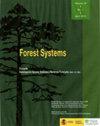Pine root exploration of standing dead tree trunks: a short-cut biocycling process
IF 0.8
4区 农林科学
Q3 FORESTRY
引用次数: 0
Abstract
Aim of study: To characterize the colonization of Pinus herrerae roots in trunks of dead standing trees and to evaluate the composition of roots and decomposing tissues of standing dead trees. Area of study. Jaguariaíva, Paraná state, Southern Brazil. Material and methods: This study evaluated root attributes in the soil, litter, and trunks of dead standing trees and the composition of wood and bark of trees. Root traits (length, mass mycorrhizal colonization, and mean nutrient concentrations), soil and organic layers, and mean nutrient concentrations of wood and bark for were analyzed by non-parametric test. Main results: Approximately 2 to 3.5 years after tree death, roots of adjacent trees in F and H horizon litter migrate into the wood/bark interface. Eight and a half years after tree death, roots of adjacent trees reached up to 3.3 m above the litter surface. At the wood/bark interface, a root mantle formed (length greater than 1 km m-2) with ~5% ectomycorrhizal colonization. Root presence in the wood/bark interface reduced P, K, and Fe concentration of dead wood and Zn concentration in bark. Research highlights: Our results indicate that roots of P. herrerae are capable of colonizing dead tree trunks as a nutrient resource pool. This nutrient acquisition mechanism may function as a shortcut in the biogeochemical cycling of nutrients in forest systems.直立死树干的松根探索:一个捷径的生物循环过程
研究目的:研究黑松根在枯死树干中的定殖特性,并对枯死树干的根组成和分解组织进行评价。研究领域。Jaguariaíva,巴拉那州,巴西南部。材料和方法:本研究评估了土壤、枯枝落叶和树干中的根属性,以及木材和树皮的成分。通过非参数检验分析了根的性状(长度、大量菌根定殖和平均养分浓度)、土壤和有机层以及木材和树皮的平均养分浓度。主要结果:树木死亡后约2至3.5年,F和H层枯枝落叶中相邻树木的根迁移到木材/树皮界面。树木死亡八年半后,相邻树木的根部高出枯枝落叶层3.3米。在木材/树皮界面,形成了根套(长度大于1 km m-2),约5%的外生菌根定殖。根在木材/树皮界面的存在降低了枯木的P、K和Fe浓度以及树皮中的Zn浓度。研究重点:我们的研究结果表明,灰蝶的根能够在枯死的树干上定植,作为营养资源库。这种养分获取机制可能是森林系统养分生物地球化学循环的捷径。
本文章由计算机程序翻译,如有差异,请以英文原文为准。
求助全文
约1分钟内获得全文
求助全文
来源期刊

Forest Systems
FORESTRY-
CiteScore
1.40
自引率
14.30%
发文量
30
审稿时长
6-12 weeks
期刊介绍:
Forest Systems is an international peer-reviewed journal. The main aim of Forest Systems is to integrate multidisciplinary research with forest management in complex systems with different social and ecological background
 求助内容:
求助内容: 应助结果提醒方式:
应助结果提醒方式:


